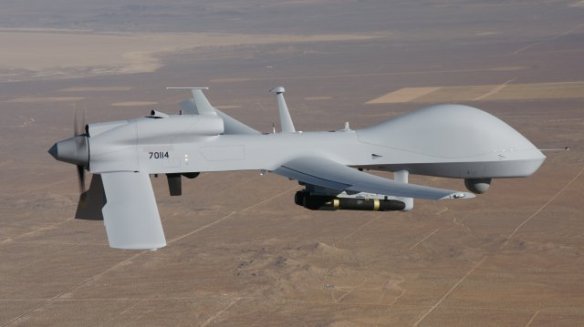MQ-1C GRAY EAGLE UNMANNED AIRCRAFT SYSTEM (UAS)
MISSION
Provides combatant commanders a real-time responsive capability to conduct long-dwell, persistent stare, wide-area reconnaissance, surveillance, target acquisition, communications relay, and attack missions.
DESCRIPTION
The MQ-1C Gray Eagle Unmanned Aircraft System (UAS) addresses the need for a long-endurance, armed (up to four HELLFIRE missiles), UAS that offers greater range, altitude, and payload flexibility.
The Gray Eagle UAS is powered by a heavy fuel engine (HFE) for higher performance, better fuel efficiency, common fuel on the battlefield, and a longer lifetime.
Its specifications include the following:
Length: 28 feet
Wingspan: 56 feet
Gross take-off weight: 3,600 pounds
Maximum speed: 150 knots
Ceiling: 25,000 feet
Range: 2,500 nautical miles via satellite communications (SATCOM)
Endurance: 24 hours
The Gray Eagle UAS company consists of nine unmanned aircraft, five Ground Control Stations (GCS), six Ground Data Terminals (GDT), one Mobile Ground Control Station (MGCS), three Satellite Ground Data Terminal (SGDT), an Automated Take-off and Landing System (ATLS), and other ground-support equipment, operated and maintained by a company of 128 Soldiers.
SYSTEM INTERDEPENDENCIES
PM–Robotic Unmanned Sensors (PM-RUS) provides the electro-optical/infrared (EO/IR) and SAR/GMTI payloads; PM–Joint Attack Munition Systems (PM-JAMS) provides HELLFIRE missiles; PM–Warfighter Information Network–Terrestrial (PM-WIN-T) provides communications relay payload
PROGRAM STATUS
- Current: Full Rate Production
PROJECTED ACTIVITIES
- 3QFY15: Follow-On Test and Evaluation
FOREIGN MILITARY SALES
None
CONTRACTORS
Aircraft:
General Atomics, Aeronautical Systems Inc. (San Diego, CA)
Ground Control Station:
Textron (Hunt Valley, MD)
Tactical Common Data Link:
L-3 Communications (Salt Lake City, UT)
The USAF Vision for a large-sized UAS (MQ-L) by 2020 is similar to the medium-sized UAS evolution leveraging autonomous, modular and open architecture technologies. The MQ-L will be capable of performing today’s manned heavy aircraft missions with one common core airframe.
Filling urgent COCOM needs first, the MQ-La, with SAR/GMTI advanced SIGINT capabilities, will complement the Global Hawk in multi-INT ISR missions. The MQ-La has the potential to replace other large manned battle management command and control (BMC2) platforms such as Joint Surveillance and Target Attack Radar System (JSTARs) and Airborne Warning and Control System (AWACS) as they approach recapitalization. Manpower requirements will be reduced during loiter and transit-operations due to increased automation and autonomy. These efficiencies are amplified when multiple large payload aircraft are teamed together through loyal wingmen technology under the direction of one pilot.
The all-weather MQ-Lb will be a multi-mission endurance aircraft capable of ISR, EW communications gateway and air mobility operations. These capabilities will enable a Large UAS FoS approach through modularity. Appropriate sets of payloads will “plug and play” in a bay. Some of the potential payloads include ISR, EA, BMC2, pallet lift capability or fuel tanks. Autonomy will increase for auto take off and land seamlessly integrated with civil and military traffic. Loyal wingmen will mature such that formations of manned and unmanned transport aircraft will disperse to land at point of need separately from each other. As technologies mature, ground operations from taxi through ground refueling and standard pallet loading will be conducted with only human monitoring of autonomous actions. For this and the follow on platform, Air Mobility Command (AMC) requirements will be balanced with Air Combat Command (ACC) ISR requirements.
The MQ-Lc common core airframe will serve as the foundation for all missions requiring a large aircraft platform. In addition to MQ-Lb mission sets, the MQ-Lc will harness autonomous and modular technologies to present capabilities to the Joint Force Commander that include air mobility, airlift, air refueling, EW, multi-INT ISR, strategic attack, global strike, CAS, air interdiction and humanitarian assistance operations. The evolution of technologies to accomplish this will begin with predictable flight scenarios, such as large cargo delivery services. This concept will develop into collaborative systems that can optimize multi-aircraft mission effectiveness. Applicable technologies are being developed and demonstrated in laboratories and universities today.
SPECIAL CATEGORY SYSTEM
The USAF vision for specialized UAS will set a number of foundational principles to guide their development and ensure compatibility with other systems. These are systems where aircraft design is integral to mission success and must be built as open architecture, non-proprietary systems to allow for cost-effective upgrades and competitive integration. Where possible, payloads must be modular in nature to allow for acquisition efficiency while maximizing operational flexibility. Finally, extreme performance parameters such as ultra-long endurance or hypersonic flight will demand high levels of autonomy. These systems may require reconsideration of maintenance and logistics support in order to adequately service the aircraft. The sensitive nature of future specialized UAS will likely drive these programs to be developed in the classified environment.
The maturity of the technologies required for the representative missions vary widely. Stealth technology sufficient for some threats is available today, but stealth technologies that would allow long loiter in a high threat environment requires further development. Extremely long endurance platforms, including high altitude balloons or large lifting surface aircraft, are under development and could be available in the near to mid-term time frame. The longest lead technology of the three depicted are hypersonic systems. The only truly hypersonic vehicle flown today is the Space Shuttle. Propulsion technology and materials that can withstand the extreme heat will likely take 20 years to develop. This technology will be the next generation air game-changer. Therefore the prioritization of the funding for the specific technology development should not wait until the emergence of a critical COCOM need.
